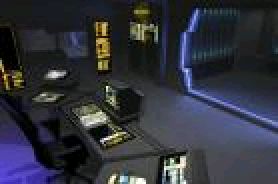Just Saying NO
Sometimes... the most useful thing to say... is NO!
Here's a sampling of a how to say "NO" around the galaxy:
+---------------+------------------------------+
| NO | Alien Language/Meaning |
+---------------+------------------------------+
| Den | No. [Ewok] |
| Muawa | No. [Wookie] |
| hia | no, oh no (interj) (Romulan) |
| ahht | no (UTA Romulan) |
| Noah | No. [Hutt] |
| Nobata | ?. No. [Hutt] |
| Nokeezx | No. [Bocce] |
| Nosa | No. [Gungan] |
| Nyeta | No. [Jawa] |
| ghobe' | no [Klingon] |
| nirsh | no [Vulcan] |
+---------------+------------------------------+
And back on planet Earth:
+-----------------------+------------------+
| Afrikaans | Nee |
| Albanian | Jo |
| Amharic | Aye |
| Arabic | laa |
| Armenian | Votch |
| Asturian | non, nun |
| Azerbaijani | - Yox |
| Basque | Ez |
| Bengali | Na |
| Bosnian | Ne |
| Breton | Nann |
| Bulgarian | Ne |
| Cantonese | m hai |
| Catalan | No |
| Chipewyan | Een-ley |
| Cornish | Na |
| Creole | Non |
| Croatian | Ne |
| Czech | Ne |
| Dagaare | Ai |
| Danish | Nej |
| Dutch | Nee |
| English | No |
| Esperanto | Ne |
| Estonian | Ei |
| Eurish | No |
| Farsi | Nah |
| Finnish | Ei |
| French | Non |
| Frisian | Nee |
| Galician | Nom - Non |
| Georgian | ara |
| German | Nein |
| Greek | O'hi |
| Gujarati | naa |
| Hawaiian | `A`ole |
| Hebrew | lo |
| Hindi | nahi |
| Holooe | M--si |
| Hungarian | Nem |
| Icelandic | Nei |
| Ido | No |
| Indonesian | Tidak |
| Interlingua | No |
| Irish | ni hea, nil |
| Italian | No |
| Japanese | Iie |
| Korean | A-nim-ni-da , |
| | A-ni-yo |
| Latin | Non, Minime |
| Latvian | Ne- |
| Lithuanian | Ne |
| Luganda | Nedda |
| Malaysian | tidak |
| Mandarin | bu shi |
| Marshallese | Jaab |
| Mazahua | pcokh |
| Norwegian | Nei |
| Occitan | Non, nani |
| | (formal) |
| Polish | Nie |
| Portuguese | Nao |
| Brazilian Portuguese | Nao |
| Quechua | Manan |
| Romanian | Nu |
| Russian | Net |
| Serbian | Ne |
| Sesotho | Tjhee |
| Sinhala | Nae- |
| Slovak | nie |
| Slovenian | Ne |
| Spanish | No |
| Swahili | Hapana |
| Swedish | Nej |
| Tagalog | Hindi |
| Thai | mai-chai/mai-oua |
| Tswana | Nnyaa. |
| Turkish | hay?r |
| Ukrainian | ni |
| Vietnamese | Khong |
| Welsh | Nage |
| Wolof | Deedeet |
| Xhosa | Hayi |
| Yiddish | neyn |
| Zulu | cha |
+-----------------------+------------------+
Travlang offers a Word of the day that gives you a different word or phrase in over 80 language. You can also receive the Word of the Day via email in any one language up to over 80.
Travlang offers free downloadable dictionaries along with the Ergane program that can run on your personal computer.
Ergane 8.0
What is Ergane?
Ergane is a multilingual translation dictionary for Windows that uses the artificial language Esperanto to translate words and short expressions from one natural language to another. Ergane is a product of Majstro Aplikaĵoj.
Ergane's user interface and manual are available in three languages: English, Esperanto and Dutch. The user interface alone is also available in Spanish.
On-line version
On this site is also available Travlang's On-line Translation Dictionary, which is an on-line version of Ergane:
MUSIC:
(from Garageband.com)
Nocturne ![]()
| |
Genre: Ambient
 | This music free to share under a Creative Commons Music Sharing License. |
Ekho
Ekho's Newsletter
![]()
![]()
Hometown: Glossop, England, United Kingdom









